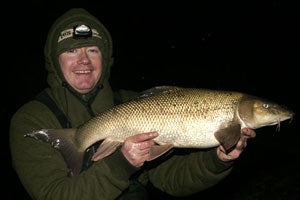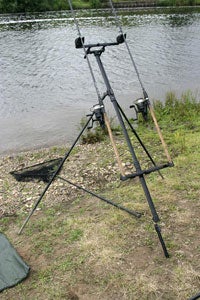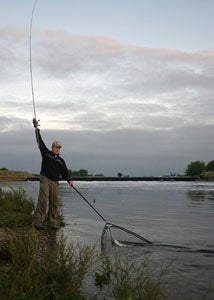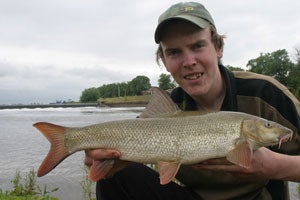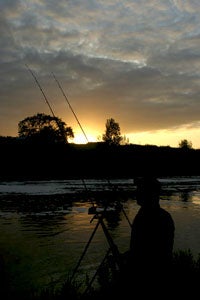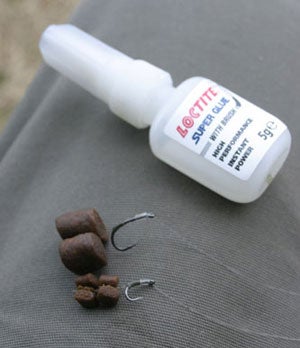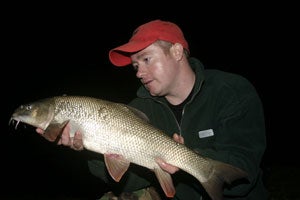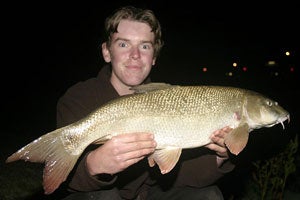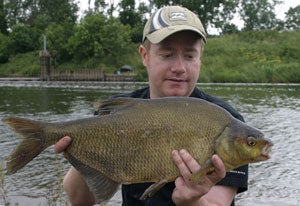With the up and coming Tidal Trent ‘fish in’ at Collingham I thought I ought to put some words together to aid those of you who haven’t fished such a venue before. This isn’t meant as a be all and end all. It’s just a view of how my Tidal fishing has developed and is designed to provide a few of you with some ideas. Although fishing at Collingham might seem alien to those of you who fish for barbel in more typical barbel venues, or those of you who don’t fish tidal waters, but there’s no need to worry. It’s still just fishing. The biggest issue is still trying to get the fish to feed – the same issue we all come up against every time we fish. Special Kit The river at Collingham is affected by the tide in varying amounts. I’ve seen it change by up to five feet and I’ve seen it not change at all. The most obvious issue is to make sure you take into account where the tide might arrive when laying your kit out. I’ve seen many people moving up the bank, only to do so another half an hour later!
All I do is look for the high water mark, where the greenery takes over the gravel and sand, and make sure I have room for my rods, unhooking mat and shelter. At low tide my rods will often be as much as fifteen feet away from the water’s edge, but it’s not an issue. In fact it allows me more room to move around when playing a fish. I use a Fox Stalker shelter, but a traditional brolly will do unless the forecast is for winds over 20mph and heavy rain. If a dry night and an air temperature minimum of 15 degrees Celsius is forecast, then the shelter is left in the rod bag. I’ve tried sleeping in a normal chair, on the floor, on a self inflating mat and so on but shelling out for a bedchair was one of the best investments I ever made. The banks at Collingham vary from sloping gravel and grass to large rocks and being able to set up a level bedchair means I get to sleep when I need to. I use a Trakker lined sleeping bag cover, but if the forecast is for a minimum air temperature below 10 degrees then the sleeping bag comes along. I prefer not to use it though as I sleep with my boots on and like to be able to get to the rods with the minimum of hindrance.
I use an adapted Fox Horizon Pod to keep the rods securely propped up but single banksticks will do in most pegs. If you are going to use banksticks, solid 48″ extendable ones used in conjunction with a keepnet angle bracket are a good idea. The flow can vary quite a bit (see www.thebarbelsociety.co.uk) and having the option to raise or lower the rods will allow you to control how your lead or feeder holds the bottom. I use alarms because I just can’t concentrate on the tips all day and all night. I have fished without but I had the odd bream hook itself while I wasn’t looking and I’ve not realised until I’ve reeled in half an hour later. If you do use alarms, please keep the volume to a minimum. Because the place can get busy hearing everyone else’s alarms all night has put many angler off fishing there at all.
Because the banks are hard gravel or rock, an unhooking mat is a must unless you wish to unhook and return your fish from the landing net. Rods You can get away with all sorts of rods. Carp rods are good for casting heavy weights accurately and will certainly be suitable for playing barbel but you’ll lose out on bite detection. The Saturday before last I had 13 fish (only three were barbel) and of those only two set the alarm off. The others were small knocks or drop backs. Quiver tip rods are great because you’ll see all the action. You might struggle if there’s a bit of extra water about but if you can get the rod tips high you should be fine.
The ideal all round rod that will cope with almost all conditions would be an Avon topped barbel rods with a test curve of around 1.75lb. That will give you the best compromise of bite detection, casting ability and absorbing the lunges of and angry barbel. Reels and Lines I use a couple of 8 or 9 year old Shimano 6000 size Baitrunners. The baitrunner facility is important because some of the barbel can be violent on the take. If you don’t have a baitrunner, just make sure you set your clutch to give line rather than have your rod dragged in.
I’ve said why I prefer Krystonite many times before and that’s what I use. In most pegs 10lb or 12lb mono is just right. Whatever you use, make sure you check the line every time you reel in. Some nights I’ve had to re-tie my rigs most casts and some nights I’ve not had a problem. I have lost fish in the past by not being thorough though. Rigs There’s no need to get complicated here. A lead clip system or running rig will work fine. Just make sure the fish can eject the lead in the event of the main line breaking. I use Drennan Super Specialist barbel hooks but any strong hook should be fine. Just check it. I use sizes between 14 and size 6 depending on the time of day with all baits being hair rigged.
I do feel it’s important to tie to rigs meticulously so to that end I make sure the gap between the bait and hair is between 2mm and 5mm (3mm is ideal) and I use a 3mm long piece of 1mm bore silicone tube to trap the hair to the hook shank. I like the line to leave the back of the shank between the bend of the hook and opposite the point. You’ll often find that after catching, or losing, a fish the silicone tube has been forced up and over the knot. Sometimes the silicone will split. Always check and don’t cut corners. Sort the rig out – re-tie it if necessary otherwise that next fish might not hook up properly and it could have been a 15lb-pounder. I use hooklengths of anything between a foot and four foot. In theory, longer hooklinks are more likely to catch fish that are wary of the lead or feeder. If I use a hook length over two feet, I’ll use a number 6 shot or two to pin the line down a little. Baiting Up I pick a spot where there is consistent flow and that is far enough from the bank that my movements onshore are less likely to spook the fish. Depending on the swim this can be anywhere from 15 to 40 yards out. Sometimes I have a quick lead around with a 1oz bomb to make sure there are no obvious snags. I don’t want to chuck all my bait somewhere I can’t fish!
I normally start off by using a small bait dropper to deliver mixed pellets and broken boilies into as tight an area as I can. If you’ve ever seen how a bait dropper works in clear water you’ll know that the bait is often released a good 8″ off the bottom as the dropper is lifted back up and that the bait flies off downstream. I use mixed pellets from 2mm to 14mm and of different shapes and types to ensure that the feed leaves a trail downstream of where I’m fishing. The lighter pellets will work their way further downstream. I clip up the bait dropper to achieve this accuracy, but I also measure out the upstream rod and mark the line at the same distance using pole elastic. I use the smallest Seymo bait dropper and put out around 20 loads of pellet. I feel using the smaller dropper gives a slightly better spread of bait than a larger dropper.
Sometimes a bit of dark fishmeal based groundbait will go in too but I do worry about this washing out of the swim and taking the fish with it. Time To Cast In During the day and into the evening, when I’m feeling fresh (usually before midnight), I fish leads or feeders that will just hold the bottom. The fish are more likely to dislodge the lead or feeder and therefore hook themselves but it means regular recasting. Later in the night I prefer to keep my baits in place for much longer in the hope of snaring bigger, more wary fish. The upstream rod is cast straight out, using the line clip for accuracy. As the rig hits the water I unclip the line and pay a bow of line out. This is often between 15ft and 30 feet depending on the flow. The more flow, the more of a bow is required to hold bottom (all other things being equal). The bow at the rig end is likely to be pinned to the deck by the flow and is therefore less likely to spook the fish. This upstream rod will often be rigged up with a feeder. It will usually be an open end job holding anything from 2oz to 5oz with 3oz being most common. This will usually contain groundbait heavily laced with pellets. The downstream rod isn’t clipped up and will be cast onto the same line. This could be anywhere from 5 yards to 25 yards downstream of the upstream rig. Ten yards is about normal, but it depends on the flow and how much space there is downstream of me.
I don’t put any feed on this rod because it’s designed to fool wary fish. I’ve seen barbel and chub feed in clear water, and for the first few hours at least, they will sit well below the main feed picking off bits of food that break away and travel down in the current. Only when they become more confident and competitive do they move right up to the feed. If you put too much feed around this downstream rod you’ll often be feeding the next peg down. That’s great for the guy fishing below you! Hence I use a grippa style lead. I’ll try different distances on the same line as my upstream rod in the hope that I might locate the fish, but I try and leave this rod alone for much longer. Bites on both rods will often be drop-backs due to the bow in the line. Don’t make the mistake that many do and think that you have to wait for the line to scream off. Hit it! More often than not the downstream rod has produced the most and the biggest fish. Speaking to other barbel anglers and this is a very common occurrence. Day To Night The Trent is fairly clear at normal level and the fish can seem so spooky in daylight to the point where you think the place was empty so if you just sit it out on normal tactics you’ll be lucky to have a sniff.
In daylight I’ve had success using small baits, such as 6mm pellets and size 14 hooks on a long hooklength and feeding dark groundbait and small pellets. I’m sure normal, brown coloured groundbait and large baits spooks the fish. Maggots will work but you’ll need a lot and you could be plagued with chublets and eels. As the sun dips out of sight I clip on rigs with shorter hooklinks, bigger hooks and bigger baits – either 14mm halibut pellets or a pair of 11mm Elips pellets are ideal. I recast every 20 minutes or so because the pellets won’t often last too long in the flow. You can prolong the life of your pellets by drilling them and storing them in a tub of oil such as Salmon Oil. Normally the fish will become much more active, crashing and rattling the rod top as they peck at the feeder or brush against the line. This is the time to fish hard as the fish are as easy to catch as they’re going to be until the following night. Often smaller barbel will show, with fish between 1lb and 5lb being much more common than some would have you believe. If you’re unlucky you might get stuck with a shoal of bream and the barbel may never push them out. That’s great if you like bream as they average about 6lb. I’ve had them up to 9lb.
After this active spell the fishing will tail off and as yet I’ve not found a way to make it continue at the same intensity. I’ve tried piling in more bait using the dropper under the theory that they’ve mopped up all the bait and moved out. I’ve tried bigger feeders, taking the feeder off, PVA bags, all sorts really. Don’t get me wrong I still expect to pick up the odd barbel, and they’re usually bigger too, but action can be sparse. I still feel I have plenty to learn and will be able to prolong these feeding spells in future. This is when I resort of sticking on a boilie (they will last all night in the water if necessary) and using pre-prepared dynamite sticks (PVA stocking mesh) containing groundbait, pellets and boilie crumb. Leads of 4oz, 5oz or even 6oz will be attached so that they are only disturbed by a hooked barbel, then it’s time to retire. Sometimes the fish have gone mad all night, or sometimes there’s been a mad spell at ‘stupid-o-clock’ but usually two or three barbel before the sun pops it’s head up again is normal. The bream may continue to feed for a couple of hours but the barbel often don’t. Forum discussion on this Fish-in
|
Welcome!Log into your account












